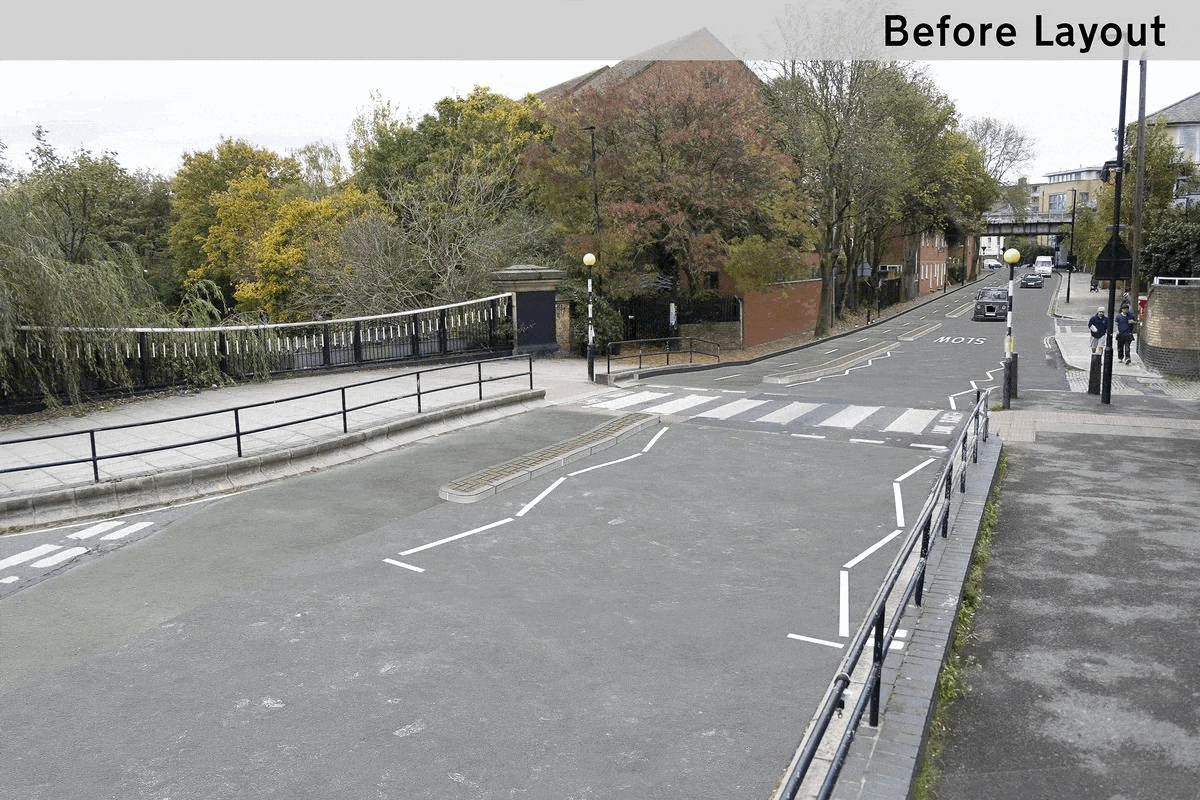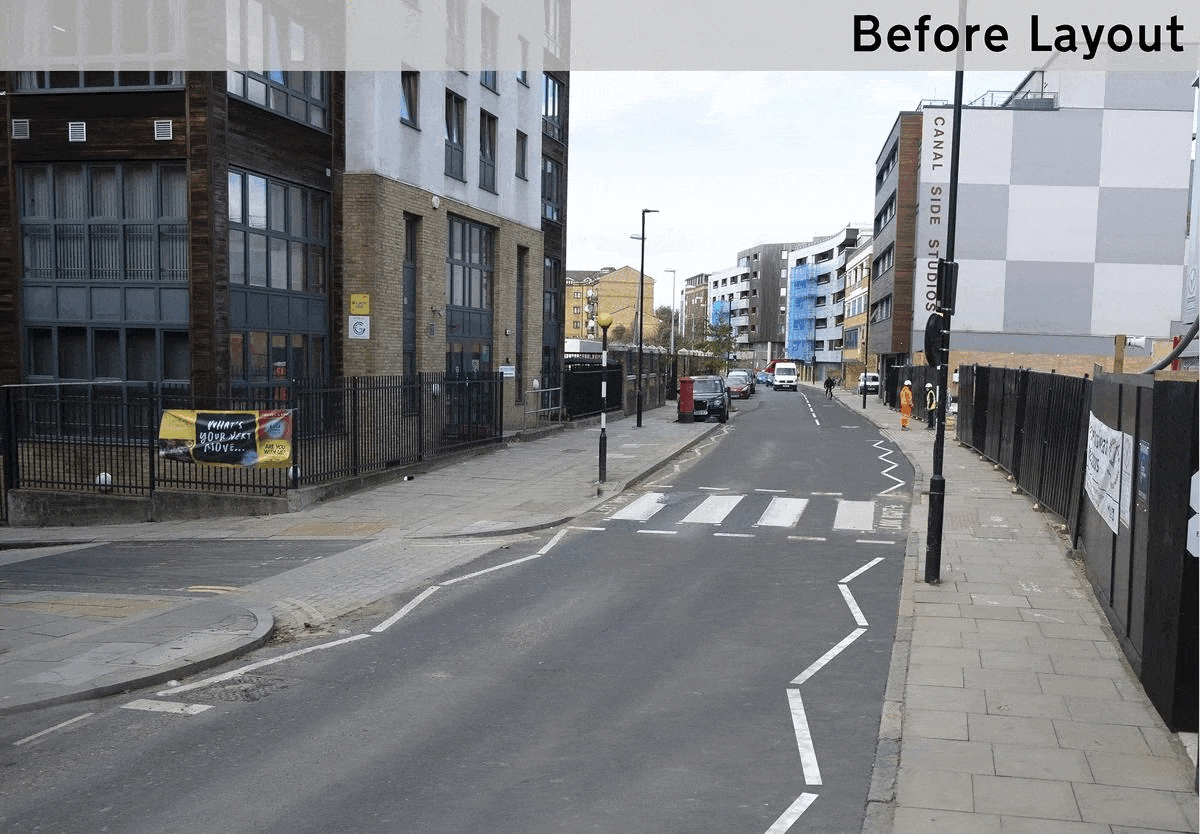St Pancras Way Safe and Healthy Streets Consultation
Results updated 27 Dec 2023
During Dec 2021 / Jan 2022 we consulted on the permanent changes proposed for St Pancras Way.
Thank you to everyone who took the time to share their views. We had over 390 responses and following the consultation, we have made the decision to implement the proposed changes as a trial.
The permanent scheme on St Pancras Way will now be constructred and we will contact all local residents and businesses ahead of the work. You can read the decision reports relating to this, and our feedback to the consultation responses in the decision report.
Links:
Overview
The Covid-19 pandemic changed how communities live, travel and work. We want to transform our streets so they have more, safe space for everyone to walk and cycle, for children to get to and from school safely, for you to be breathing cleaner air, to reduce carbon emissions from road transport, and for businesses to flourish. We want to ensure that our streets support recovery from the pandemic and provide a lasting legacy of greener, safer, healthier travel.
We’ve been trialling changes on St Pancras Way to help make streets safer and healthier by improving cycle lanes to help make getting around by bike safer and easier. This consultation sets out proposals to:
- Make the current, trial cycle lanes on St Pancras Way permanent, with various further improvements proposed to the cycle facilities
- Make a series of other changes to St. Pancras Way, and adjoining streets, to help make those streets safer and healthier, including a number of pedestrian improvement measures
London Borough of Camden is now consulting on making the following changes permanent, by introducing the new measures in this area to improve conditions for walking as well as cycling.
We are proposing the following measures:
- Replacing the temporary ‘wand’ cycle lane segregation on St. Pancras Way with new raised stepped cycle tracks. This is because ‘wands’ are easily broken, and stepped cycle tracks provide a better ride quality with a more useable width. This also improves emergency vehicle response times (vehicles can pull over onto the cycle tracks to allow emergency vehicles through).
- Retaining the shared-use bus stop border between Camden Road and Agar Grove to provide safe continuous cycling and to minimise delays for bus passengers.
- Upgrading three existing zebra crossings near Georgiana Street, College Grove and Granary Street to “raised” zebra crossings, providing level crossing points for pedestrians and traffic calming features to slow vehicles.
- Two of these existing zebra crossings would also be upgraded to raised 'parallel zebra' (cycle and pedestrian) crossings near Georgiana Street and Pratt Street, providing safer crossing points for cyclists and pedestrians.
- Creating a new shared space (cycle and pedestrian) area on the footway on the north western side of the junction of St Pancras Way and Georgiana Street, giving the opportunity for southbound cyclists on St Pancras Way to access Georgiana Street when using the new parallel crossing
- Adding blue cycle lane surfacing across side roads and junctions with cycle symbols to provide an increased awareness of cyclists.
- Installing ‘blended pedestrian crossings’ across side roads of Wrotham Road, Barker Drive and College Grove. This is to provide pedestrian priority and reduce vehicle speeds at side roads.
- Installing approximately 9 new trees to improve air quality, biodiversity, shade and improve the public realm of the street.
- Installing approximately 6 new benches to provide opportunities to rest, particularly for the elderly and people with disabilities.
- Installing 8 new cycle parking stands along the route and two cycle hangars on Wilmot Place (replacing 5m or Residents parking near the junction of St Pancras Way) and Pratt Street (replacing 5m of single yellow line between St Pancras Way and Royal College Street) to provide people a safe place to store their bikes.
- Creating a new segregated westbound contraflow cycle lane on Pratt Street, connecting St Pancras Way with Royal College Street
- Replacing the single yellow lines on Pratt Street, between St Pancras Way and Royal College Street, with double yellow lines and double kerb blips, to ensure through traffic is not blocked by vehicles.
- Removing 3 paid for parking spaces from the north side of Pratt St and installing 5 new shared-use (paid for parking and residents permit holders) spaces on the south side of Pratt Street, between St Pancras Way and Royal College Street, creating more spaces for residents to park
- Installing a 16m loading bay on Pratt Street, between St Pancras Way and Royal College Street, providing loading/unloading facilities for local businesses and residents
- Installing new double yellow lines with double blip markings (no parking/waiting at any time) along St Pancras Way to prevent vehicles from parking and loading on the cycle lane.
Below you can view visualisations of the proposed changes to the scheme which will automatically change while you watch. They will show you what two areas of St Pancras Way, north of Georgiana Street and College Grove, looked like before the scheme, what they look like now and what the permanent proposals would look like.

Why your views matter
As 69% of households in Camden do not own a car and public transport patronage levels remain lower than before the pandemic, we know that safe and easy walking, cycling and scooting routes are more important than ever. Supporting and encouraging those who are able to walk and cycle, by creating safer streets will ensure that there is more space available on public transport and on our roads for those who need it the most.
Your views are important in providing feedback both on the proposed scheme as a whole and elements of it, and we would therefore welcome your responses on the pages that follow.
What happens next?
After the consultation, a decision report will be produced and published online via our website. Local residents and stakeholders will be notified of the outcome. The report will consider a broad range of information including consultation responses, feedback received during the trial period, relevant policies and other data/information including monitoring information collected during the trial period.
All of this information will be considered in making a recommendation in the report about whether, at the end of the trial period, the experimental scheme should be made permanent, modified or allowed to lapse.
What happens next
After the consultation, a decision report will be produced and published online via our website. Local residents and stakeholders will be notified of the outcome. The report will consider a broad range of information including consultation responses, feedback received during the trial period, relevant policies and other data/information including monitoring information collected during the trial period.
All of this information will be considered in making a recommendation in the report about whether, at the end of the trial period, the experimental scheme should be made permanent, modified or allowed to lapse.
Areas
- Cantelowes
- St Pancras and Somers Town
Audiences
- Anyone from any background
Interests
- Transport and streets



Share
Share on Twitter Share on Facebook